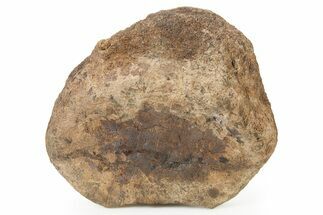This Specimen has been sold.
17" Long Triceratops Rib Section - South Dakota
This is a 17" long rib section from one of the most iconic dinosaurs Triceratops horridus. It comes from the Hell Creek Formation in South Dakota, making it approximately 66 million years old. The rib section is pretty solid with a few repaired cracks and no restoration.
It comes with the pictured, acrylic and brass display stand.
This specimen was found at a private ranch in Butte County, South Dakota this summer. It comes from a quarry known as the "Tooth Draw Quarry" that has produced many high quality dinosaur teeth over the past several decades. In the Late Cretaceous some 65 million years ago, this quarry was located in a sub-tropical floodplain that would have been similar to modern day coastal Louisiana. It consists of 2 meters of alternating sandstone and gravel, representing a river channel lag deposit. It contains many isolated dinosaur teeth including T-Rex, Nanotyrannus, Raptors and Triceratops, but teeth of this high quality are rare finds.
It comes with the pictured, acrylic and brass display stand.
This specimen was found at a private ranch in Butte County, South Dakota this summer. It comes from a quarry known as the "Tooth Draw Quarry" that has produced many high quality dinosaur teeth over the past several decades. In the Late Cretaceous some 65 million years ago, this quarry was located in a sub-tropical floodplain that would have been similar to modern day coastal Louisiana. It consists of 2 meters of alternating sandstone and gravel, representing a river channel lag deposit. It contains many isolated dinosaur teeth including T-Rex, Nanotyrannus, Raptors and Triceratops, but teeth of this high quality are rare finds.
About Triceratops
Triceratops is one of the most recognized and intriguing of the North American ceratopsid dinosaurs. They stomped around the Late Cretaceous (around 68-66 mya), brandishing their three-pronged and bony frilled skulls, chewing on fibrous plants. They struggled against large predators, stood their ground, and tried not to be devoured by the ferocious Tyrannosaurus rex.
The head on a Triceratops may have been an intimidating show rather than a stabbing, defensive trident and imposing shield for inter-species jousting. Researchers have given close scrutiny to the holes, or fenestrae, of other ceratopsid crests. In the past, the holes within the shield were used to confirm separate species.
Individual Triceratops are estimated to have reached up to 9 meters (29.5 feet) in length, 3 meters (9.8 feet) in height, and weighed up to 26,000 pounds. The largest known skull is estimated to have been 2.5 meters (8.2 feet) long and would have extended almost a third of the length of the mature individual. The pointed horns were approximately 1 meter (3 feet) long. With its sturdy build and powerful legs, Triceratops could have ripped open the predator that wanted this herbivore for dinner.
One of the most abundant of the large Cretaceous fauna, Triceratops plucked low growth with its beak-tipped jaws. Triceratops teeth were arranged in groups, called batteries, of 36 to 40 tooth columns, in each side of each jaw. Each column contained about 3 to 5 stacked teeth, depending on the individual’s size. This produced a range of 432 to 800 teeth, of which only a fraction were in use at any given time (due to tooth replacement). The great size and quantity of teeth suggests that they ate large volumes of fibrous plants. These were possibly palms, cycads, and ferns.
Triceratops was designated as the state fossil of South Dakota in 1988.
Triceratops is one of the most recognized and intriguing of the North American ceratopsid dinosaurs. They stomped around the Late Cretaceous (around 68-66 mya), brandishing their three-pronged and bony frilled skulls, chewing on fibrous plants. They struggled against large predators, stood their ground, and tried not to be devoured by the ferocious Tyrannosaurus rex.
The head on a Triceratops may have been an intimidating show rather than a stabbing, defensive trident and imposing shield for inter-species jousting. Researchers have given close scrutiny to the holes, or fenestrae, of other ceratopsid crests. In the past, the holes within the shield were used to confirm separate species.
Individual Triceratops are estimated to have reached up to 9 meters (29.5 feet) in length, 3 meters (9.8 feet) in height, and weighed up to 26,000 pounds. The largest known skull is estimated to have been 2.5 meters (8.2 feet) long and would have extended almost a third of the length of the mature individual. The pointed horns were approximately 1 meter (3 feet) long. With its sturdy build and powerful legs, Triceratops could have ripped open the predator that wanted this herbivore for dinner.
One of the most abundant of the large Cretaceous fauna, Triceratops plucked low growth with its beak-tipped jaws. Triceratops teeth were arranged in groups, called batteries, of 36 to 40 tooth columns, in each side of each jaw. Each column contained about 3 to 5 stacked teeth, depending on the individual’s size. This produced a range of 432 to 800 teeth, of which only a fraction were in use at any given time (due to tooth replacement). The great size and quantity of teeth suggests that they ate large volumes of fibrous plants. These were possibly palms, cycads, and ferns.
Triceratops was designated as the state fossil of South Dakota in 1988.
SPECIES
Triceratops horridus
LOCATION
Butte County, South Dakota
FORMATION
Hell Creek Formation
SIZE
17" long
CATEGORY
SUB CATEGORY
ITEM
#6025
We guarantee the authenticity of all of our specimens.
 Reviews
Reviews











